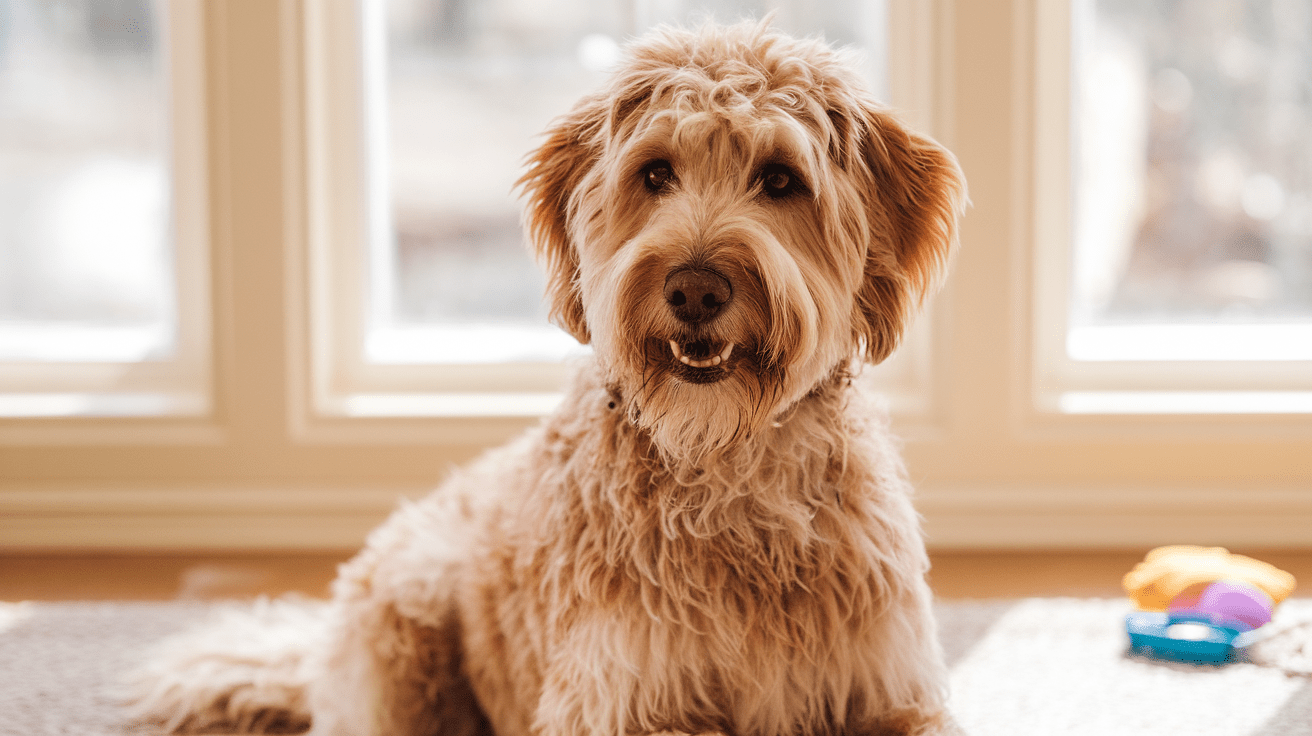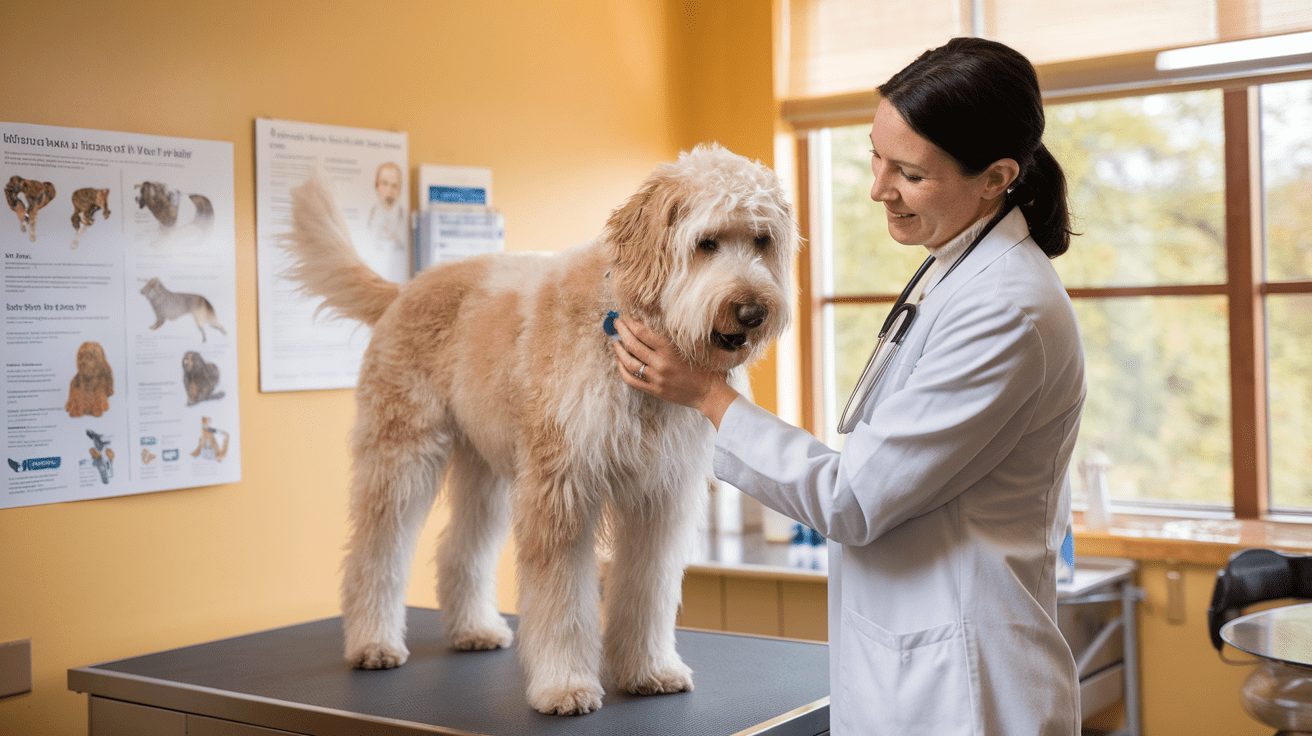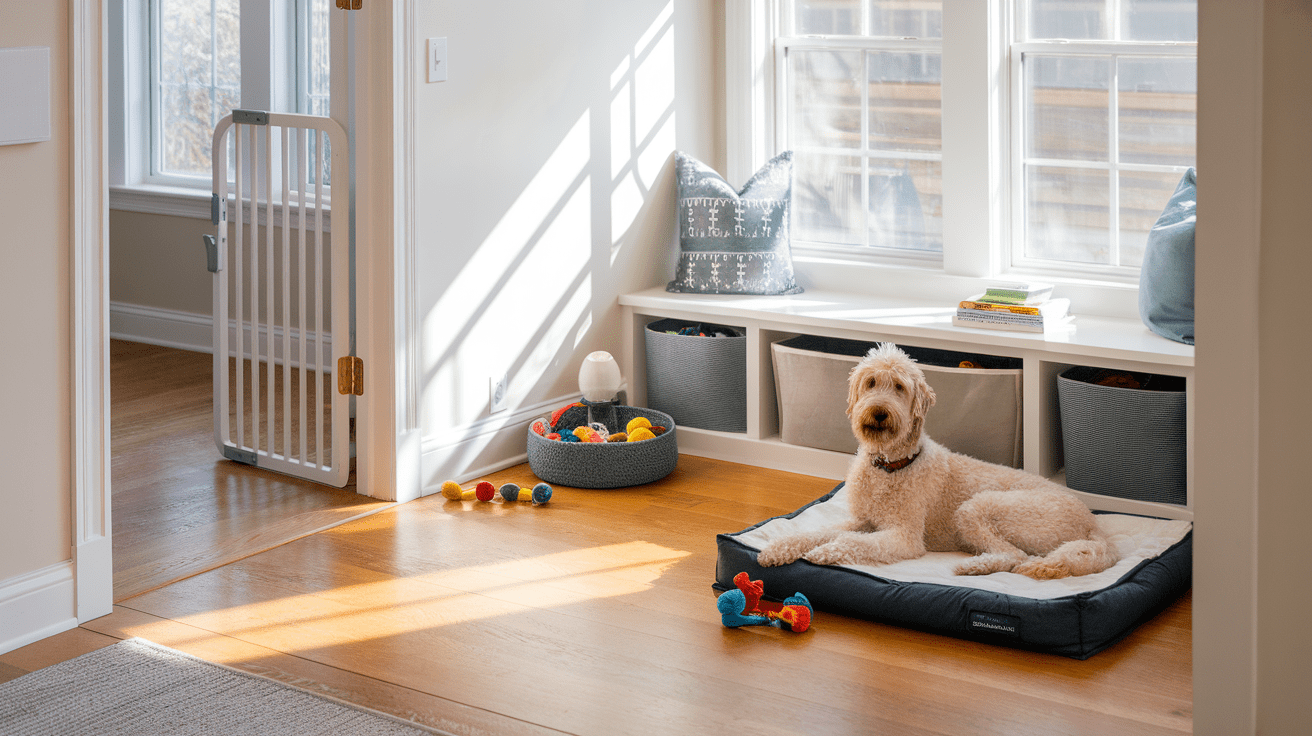Complete Guide to Labradoodles: Key Takeaways
- ✓ Breed Origin: Created in 1988 in Australia as a hypoallergenic guide dog, combining Labrador Retriever and Poodle qualities.
- ✓ Temperament: Highly intelligent, social, and adaptable dogs that make excellent family pets and are great with children.
- ✓ Care Requirements: Need regular grooming every 6-8 weeks and 30-60 minutes of daily exercise for optimal health.
- ✓ Coat Types: Come in three varieties – wool, fleece, or hair – affecting grooming needs and shedding levels.
- ✓ Health Considerations: Generally healthy but can inherit conditions from both parent breeds; regular vet check-ups recommended.
Are you considering adding a Labradoodle to your family? As a veterinarian who’s treated countless designer breeds, I can tell you these lovable hybrids have taken the dog world by storm – and for good reason. According to the American Kennel Club, Labrador Retrievers have been America’s most popular breed for 31 consecutive years, and when combined with the intelligence of a Poodle, you get something truly special.
I remember treating my first Labradoodle named Max – a goofy, gentle giant who perfectly embodied why this breed has captured hearts worldwide. These intelligent, affectionate, and allergy-friendly dogs offer the best of both parent breeds. Whether you’re a first-time dog owner or an experienced enthusiast, this comprehensive guide will walk you through everything you need to know about Labradoodles – from their fascinating origin story to practical care tips that ensure a happy, healthy life together.
What is a Labradoodle?

Having treated hundreds of Labradoodles over my veterinary career, I can tell you that these charming dogs are a purposeful cross between a Labrador Retriever and a Poodle. What started as a specialized breeding program has evolved into one of the most sought-after designer breeds worldwide.
Origin and History
The Labradoodle story began in 1988 when Australian breeder Wally Conron created the first intentional Lab-Poodle cross for Guide Dogs Victoria. His goal was to develop a guide dog suitable for people with allergies. According to Guide Dogs Victoria, this innovative breeding program sparked a global phenomenon, though interestingly, Conron later expressed concerns about the breed’s overwhelming popularity leading to irresponsible breeding practices.
Physical Characteristics
Labradoodles showcase a delightful blend of their parent breeds’ features. They typically stand 14-24 inches tall and weigh between 15-65 pounds, depending on whether they’re miniature, medium, or standard size. Their most distinctive feature is their coat, which can be:
• Wool – Similar to a Poodle’s coat, tightly curled and minimal shedding
• Fleece – Soft with loose waves
• Hair – More similar to a Lab’s coat, straighter and more likely to shed
Different Types and Generations
In my practice, I often explain to pet parents that Labradoodle generations can significantly impact their characteristics. The main types include:
• F1 – First-generation cross (50% Lab, 50% Poodle)
• F1B – F1 Labradoodle bred back to a Poodle (75% Poodle, 25% Lab)
• F2 – Two F1 Labradoodles bred together
• Multi-gen – Third generation and beyond
I recently treated a lovely F1B Labradoodle named Luna, whose coat was particularly interesting – it perfectly demonstrated how breeding back to a Poodle can create that highly desired non-shedding coat while maintaining the friendly Labrador temperament. Understanding these generations is crucial for potential owners to choose a dog that matches their lifestyle and expectations.
Personality and Temperament

In my veterinary practice, I’ve observed that Labradoodles consistently rank among the most adaptable and well-rounded dogs I treat. According to a study published in Applied Animal Behaviour Science, hybrid breeds like Labradoodles often exhibit a balanced temperament that combines the best behavioral traits of both parent breeds.
Intelligence and Trainability
Just last week, I worked with a Labradoodle named Charlie who learned a complex medication routine in just three sessions – a testament to their remarkable intelligence. These dogs inherit the Poodle’s sharp mind and the Labrador’s eagerness to please, making them exceptionally trainable. They excel in:
• Basic obedience training
• Advanced trick training
• Therapy work
• Agility courses
Social Behavior
Labradoodles are natural social butterflies. Their friendly demeanor makes them excellent companions in various settings. They typically show low aggression levels and high sociability, though each dog has its unique personality. I always tell my clients that proper socialization during puppyhood is crucial – it’s like giving your dog the social skills they need to navigate the world confidently.
Family Compatibility
As both a veterinarian and someone who regularly interacts with family dogs, I can confidently say that Labradoodles are exceptional family pets. They demonstrate remarkable patience with children and adapt well to various living situations. Their gentle nature, combined with playful energy, makes them ideal for:
• Families with children
• Multi-pet households
• Active singles or couples
• Elderly individuals seeking companionship
A particularly memorable patient of mine, a Labradoodle named Bella, perfectly embodies this adaptability. She seamlessly transitioned from being an only pet to welcoming a new baby and later a kitten into her home. However, potential owners should remember that these dogs thrive on human interaction and can develop separation anxiety if left alone for extended periods.
Health and Care Requirements

After treating Labradoodles for over a decade, I’ve noticed these hybrid dogs generally enjoy robust health. However, like all breeds, they have specific health considerations that owners should monitor. According to a UC Davis Veterinary Medicine study, mixed-breed dogs can inherit health conditions from both parent breeds, though they often show lower incidence rates than purebreds.
Common Health Issues
I recently treated a Labradoodle named Cooper who reminded me why regular health screenings are so crucial. While generally healthy, Labradoodles may be prone to:
• Hip and Elbow Dysplasia – Inherited from both parent breeds
• Progressive Retinal Atrophy – An eye condition that requires monitoring
• Ear Infections – Especially common in dogs with floppy ears
• Von Willebrand’s Disease – A blood clotting disorder
• Addison’s Disease – A hormonal condition requiring lifelong management
Grooming Needs
Grooming a Labradoodle is like maintaining a garden – it requires regular attention to prevent overwhelming growth. Their grooming needs vary based on coat type, but typically include:
• Regular brushing – 2-3 times weekly for fleece/wool coats
• Professional grooming – Every 6-8 weeks
• Nail trimming – Monthly or as needed
• Ear cleaning – Weekly, especially for swimming enthusiasts
Exercise Requirements
These energetic dogs need substantial physical activity to maintain their health and happiness. Think of exercise as their daily mental and physical reset button. A proper exercise routine should include:
• 30-60 minutes of daily active exercise
• Mental stimulation through puzzle toys and training
• Swimming (most Labradoodles love water!)
• Interactive play sessions
I always tell my clients that a well-exercised Labradoodle is a well-behaved Labradoodle. Just last month, I worked with a family whose Labradoodle showed destructive behavior – once we adjusted their exercise routine to include morning runs and afternoon training sessions, the unwanted behaviors virtually disappeared. Remember, a tired dog is a good dog, but always start exercise routines gradually and adjust based on your dog’s age and energy level.
Choosing and Raising a Labradoodle

As someone who’s guided numerous families through the Labradoodle adoption process, I can tell you that choosing the right puppy and starting their journey on the right paw is crucial. According to the ASPCA, approximately 3.3 million dogs enter shelters annually, making informed pet selection vital for creating lasting bonds and preventing surrenders.
Finding Reputable Breeders
Just last month, I helped a family navigate away from a potentially problematic breeder situation. Finding a reputable breeder is like choosing a lifetime partner for your journey into dog parenthood. Look for breeders who:
• Provide health clearances for both parent dogs
• Allow visits to see the puppies and their living conditions
• Ask you detailed questions about your lifestyle and expectations
• Offer ongoing support and guidance
• Have transparent breeding practices and documentation
Puppy Selection Tips
Selecting your Labradoodle puppy is an exciting process that requires careful consideration. I always tell my clients it’s like matching personalities in a dance partnership. When evaluating puppies, observe:
• Energy levels – Watch how they interact with littermates
• Responsiveness – Notice how they react to human contact
• Health indicators – Clear eyes, clean ears, and healthy coat
• Temperament – Look for a balance between playful and calm
I remember helping a retired couple choose their Labradoodle. They initially wanted the most energetic puppy in the litter, but after discussing their lifestyle, we found a more mellow pup that became their perfect companion.
Training and Socialization
Starting training early is essential for developing a well-adjusted adult dog. Think of socialization as your puppy’s introduction to the world – it’s their foundation for becoming a confident, friendly adult. Focus on:
• Early positive exposure to different people, animals, and environments
• Basic obedience training beginning at 8-10 weeks
• Consistent house training routines
• Positive reinforcement techniques
Remember that each puppy develops at their own pace. One of my patients, a Labradoodle named Scout, seemed shy during early socialization but blossomed into a confident therapy dog through patient, consistent training. The key is maintaining gentle persistence while respecting your puppy’s individual personality and comfort levels.
Living with a Labradoodle

After years of guiding Labradoodle owners through their journey, I can confidently say that living with these intelligent hybrids is both rewarding and manageable with the right preparation. According to a recent study by the American Pet Products Association, pet owners spend an average of $1,480 annually on basic dog care – a figure that’s particularly relevant for Labradoodle owners planning their pet budget.
Diet and Nutrition
Proper nutrition forms the cornerstone of a healthy Labradoodle’s life. Just last week, I worked with a Labradoodle named Rocky whose energy levels transformed dramatically after adjusting his diet. A balanced diet should include:
• High-quality protein sources
• Appropriate portions based on size and activity level
• Controlled feeding schedules to prevent obesity
• Fresh water available at all times
I often compare feeding a Labradoodle to fueling a high-performance car – the better the fuel, the better the performance. These dogs typically need 2-3 cups of food daily, divided into two meals, though this varies based on size, age, and activity level.
Space Requirements
While Labradoodles can adapt to various living situations, they thrive best with adequate space. Think of their space needs like a growing child – they need room to play, rest, and explore. Essential space considerations include:
• A designated sleeping area
• Indoor play space for rainy days
• Secure outdoor area for exercise
• Storage space for toys and supplies
One of my clients successfully raised their Labradoodle in an apartment by compensating with frequent walks and park visits. The key is creating an enriching environment, regardless of your home’s size.
Cost Considerations
Living with a Labradoodle requires financial planning. Beyond the initial purchase price ($1,500-$3,000 from reputable breeders), ongoing expenses include:
• Regular veterinary care and preventive medications
• Professional grooming (approximately every 6-8 weeks)
• Quality nutrition and treats
• Training classes and supplies
• Pet insurance (highly recommended)
I remember counseling a young couple about the real costs of Labradoodle ownership. We created a monthly budget that helped them prepare for both routine expenses and unexpected veterinary care. Being financially prepared ensures you can provide the best care for your furry family member throughout their 12-15 year lifespan.
Frequently Asked Questions About Labradoodles
Conclusion
After treating countless Labradoodles throughout my veterinary career, I can confidently say these remarkable hybrids offer an exceptional blend of intelligence, affection, and adaptability. While they require dedicated grooming, consistent exercise, and thoughtful training, the rewards of Labradoodle ownership far outweigh the responsibilities. These dogs truly shine as family companions, whether you’re an active single, growing family, or retiree seeking a loving pet. Remember that success with a Labradoodle comes down to proper research, preparation, and commitment to their well-being. If you’re ready for a devoted, intelligent, and playful companion who will keep you smiling for years to come, a Labradoodle might be your perfect match. Just ensure you’re prepared for the time, financial, and emotional investment these wonderful dogs deserve.
While this guide covers everything you need to know about Labradoodles, proper training is crucial for raising a well-behaved companion. Check out our comprehensive Proven Labradoodle Training Guide to master 15 essential skills that will help your Labradoodle become a model family member




